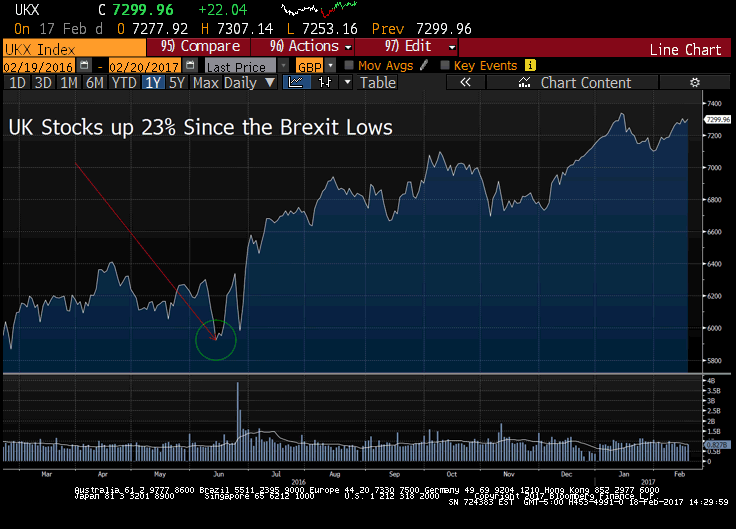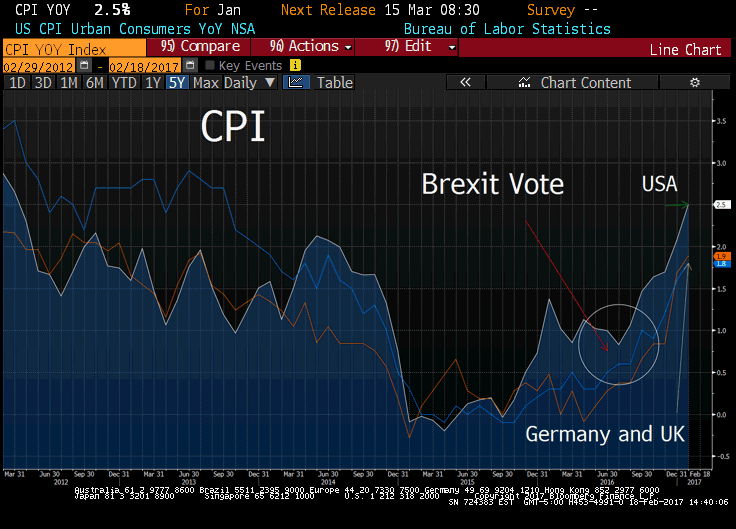Join our Larry McDonald on CNBC’s Trading Nation, this Wednesday at 2:20pm
Don’t miss our next trade idea. Get on the Bear Traps Report Today, click here“Congress — we’re all tied up in knots. The (Better Way) House Tax Reform plan won’t get 10 votes in the Senate.”
Senator Lindsey Graham, South Carolina, February 15, 2017
As we noted in our New York Times bestseller, “A Colossal Failure of Common Sense,” correlations within the S&P 500 nearly touched 1 (hit 94% in 2008, see below**) in those fateful days following Lehman Brothers’ collapse.
As fears surge in markets, stocks as well as different sectors start acting more and more and more like each other. Think of a powerful black hole sucking up everything in its path, one by one even the highest quality names get pulled into the abyss.
As we look at the first sixty days of 2017, we’re witnessing a massive re-pricing of risk. It’s as if there is no risk. Markets have moved past the long feared Brexit and U.S. election votes, they’re looking forward to lofty promises of tax cuts and deregulation.
Sector Rotation
Steady sector rotation has had a calm hand in pushing correlations lower in 2017. Over the last sixty days, the well advertised Trump “reflation trade” brought billions into financials, consumer cyclicals and small caps stocks (out of utilities, consumer staples and large capitalization – FANG -stocks). It’s been an eerie perfect pass of the baton from monetary policy to hopes for fiscal follow through in Washington.
The data below is nothing short of stunning, current correlations are through the 2007 lows!
- S&P 500 Sector Correlation
2017: 21%
2016: 67%
2015: 77%
2014: 55%
2013: 57%
2012: 68%
2011: 84%
2010: 74%
2009: 88%
2008: 94%**
2007: 28%
2006: 32%
2005: 51%
2004: 57%
2003: 68%
2002: 79%
2001: 82%
2000: 65%
Bear Traps Report, Bloomberg data
Sector correlation analysis is part of our 27 Lehman Systemic Risk Index of Indicators. With certainty we can say, over the years sector correlations in the low 20s are HIGHLY unsustainable, a real warning sign to lighten up on exposure to equities. Today, we’re well through the 2006-7 lows, an EXTREME level of equity market complacency. No matter what the media tells you, since the Trump election fear just does not exist in financial markets. Both sector and stock correlations are at all time lows.
2. Over the last year correlation plunged as complacency surged, we focused on EM vs DM below.
Emerging vs. Developed Market Correlation
Feb 2017: 28% (Dollar Index 100.90)
Feb 2016: 82% (Dollar Index 100.90)
Bear Traps Report, Bloomberg data
Remarkably, correlation between EMs and DMs has been extremely low relative to an elevated U.S. dollar DXY index. Higher commodity prices, China’s controlled currency devaluation, as well as their 2016 stimulus plan have been supportive of lower correlations.
3. With Correlations Near Record Lows, Lets Look at Crowded Trades
Commodity Futures Trading Commission
Net Speculative Bond Positions
2017: -$140B
2016: +5B
2015: -$26B
2014: -$40B
2013: +18B
2012: +$22B
2011: -$20B
2010: -5$B
2009: +$11B
2008: +$84B
2007: +$50B
CFTC data, 10 year equivalent, in billions
Will the last guy / gal getting into the reflation – short bond trade please close the door, there’s no room in here. If you ask Wall St., you can’t find a bond bull. Positioning is over the top bearish on bonds, one very crowded trade.
4. Wilshire 5000: Equity Mkt Cap to U.S. GDP
The Buffett Indicator
2015: 122.5%
2014: 110.3%
2013: 92.4%
2010: 81.1%
2009: 56.5%
2008: 68.2%
2007: 105.2%
2006: 93.4%
Join our Larry McDonald on CNBC’s Trading Nation, this Wednesday at 2:20pm
Pick Up our latest report here:
Don’t miss our next trade idea. Get on the Bear Traps Report Today, click here
 After all the Brexit horror headlines, UK stocks are up 23% from the June lows.
After all the Brexit horror headlines, UK stocks are up 23% from the June lows.

